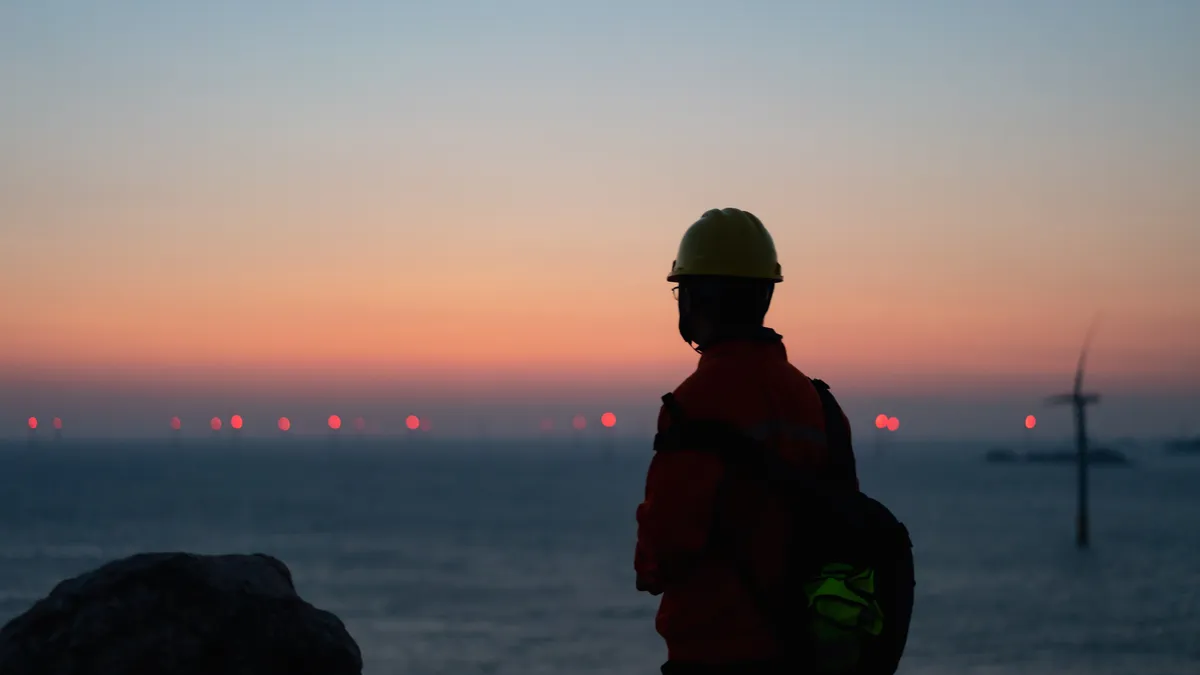This is the latest installment in Utility Dive’s “Taking Charge” series, where we engage with power sector leaders on the energy transition.
As the budding U.S. offshore wind industry expands, German multinational energy company RWE is buying in — it became the country’s first tricoastal offshore wind developer when it secured leases offshore New York, California and Louisiana.
“We recognize that an industry takes time to build up, and that's what this industry has been doing for the last number of years,” said Sam Eaton, RWE’s Offshore Wind U.S. CEO. “What I'm excited about right now is what I see as those signs of maturation, and that momentum building in the offshore wind sector here in the U.S.”
RWE purchased a lease off the coast of Northern California in late 2022 and plans to develop the 1.6-GW Canopy Offshore Wind farm there; in 2023, the company was the sole winner in a Gulf of Mexico auction that received tepid bidding.
The two leases offshore Texas went unsold in that auction, but RWE secured the remaining lease offshore Louisiana, which holds up to 1.24 GW in generation potential, according to the Bureau of Ocean Energy Management. Eaton said he thinks about the Gulf of Mexico “as an offshore energy hub” thanks to the region’s decades of involvement with the oil and gas industry.
Since 2022, RWE has been working with Greater New Orleans, an economic development agency, to boost the local offshore wind supply chain, tech development and workforce. Over the course of that partnership, Eaton said, the two have “identified over 120 companies in Louisiana that are already ready to provide services into the offshore wind industry based on their experience in the offshore oil and gas industry.”
“I don't think we could be more grateful, or laud enough, [RWE’s] — quite frankly, let's just call it from a business perspective, their risk-taking behavior here,” said Cameron Poole, an energy and innovation associate at GNO. “And risk taking with confidence, meaning they see this potential, and they see a pathway to unlock it.”
While there is “tremendous opportunity” for offshore wind development in the Gulf, Poole said, the existing turbine classes aren’t built to capitalize efficiently on the Gulf’s lower wind speeds, and hurricanes pose certain risks.
“I think Louisiana and RWE are this perfect match in that RWE is a developer that sees this vision through their efforts in Maine and in Europe — they have internal innovation practices that have successfully introduced new technologies, new strategies and new approaches that have pushed this industry forward,” he said. “And we don't expect anything less in the way we're partnering here to unlock the Gulf of Mexico.”
RWE worked to help develop the Gulf of Maine’s New England Aqua Ventus floating offshore wind pilot project and Maine Research Array before selling its shares in both in 2023, saying in a release that it had “gained valuable technological knowledge” in the process.
Eaton said that RWE’s global portfolio and comfort with technological innovation has also informed its approach to California, where deeper waters necessitate floating wind.
RWE has built two floating offshore wind pilot projects — the 3.6-MW TetraSpar project off the coast of Norway, and the 2-MW DemoSATH project off the coast of Spain — which “were really designed to allow us to get familiarity with floating offshore wind technologies,” Eaton said.
That experience prepared the company for “some very esoteric design considerations around how we're going to select the specific turbine foundations, considerations we need to take into account in the design around the cables themselves,” he said. “And just as importantly, the health and safety of our employees when they are climbing aboard a floating foundation, and how that differs from the more traditional fixed bottom technologies.”
Over the next five to 10 years, as RWE develops Canopy Offshore Wind in the Pacific, Eaton said the company plans to focus “first and foremost” on engaging with the local community and gathering feedback on how to make the project as successful as possible.
Eaton is optimistic about the future of the U.S. offshore wind industry, despite the recent headwinds it faced from macroeconomic factors like inflation — “[those challenges] affect every part of the economy,” he said.
He pointed to the fact that there are just under 200 MW of capacity currently operating in the U.S., while that number should reach 1,000 MW by the same time next year — with 13 GW “directly behind that,” having already received certain federal approvals.
“That tells me and signals to me that we have the foundations for a strong industry here in the U.S. that is now building momentum,” Eaton said. “That gets me quite excited, to be frank with you.”























